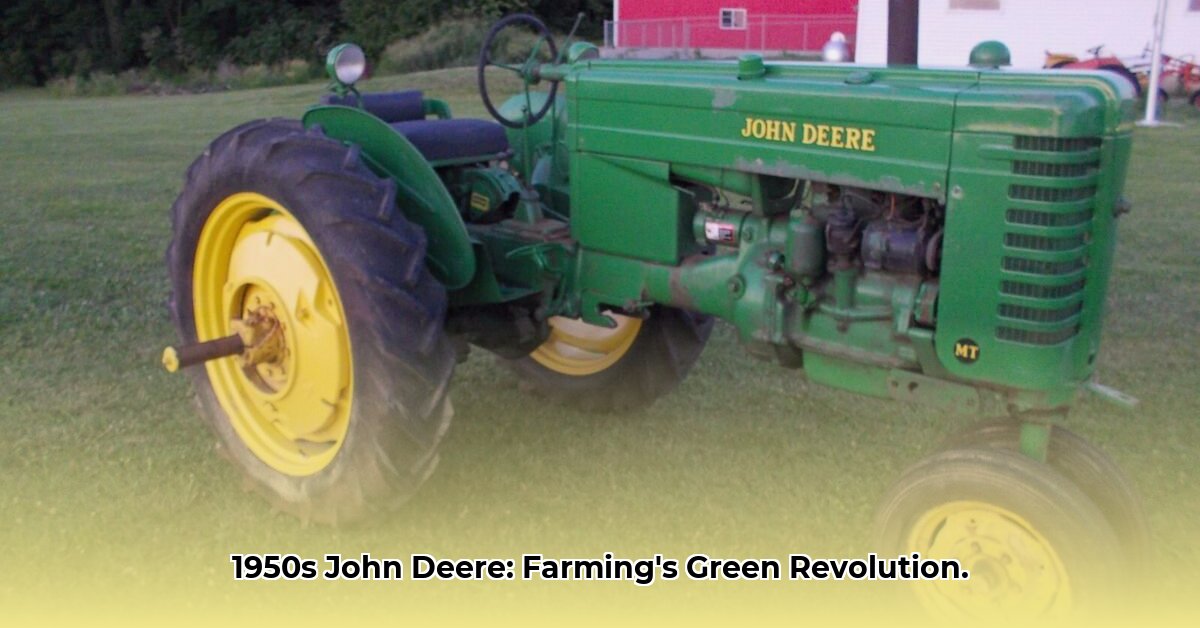
The 1950s witnessed a dramatic shift in American agriculture, fueled by technological advancements and a post-war boom. Central to this transformation were John Deere tractors, which moved from dependable workhorses to powerful and versatile machines. This article explores the technological leap forward represented by 1950s John Deere tractors, highlighting their impact on farming practices while acknowledging the then-unconsidered environmental consequences. For more on tracked Deere models, see tracked John Deere tractors.
From Model D to Modern Marvels: A Decade of Transformation
The John Deere Model D, a mainstay of the 1930s and 40s, served farmers reliably. However, the post-war era demanded greater efficiency and power. The 1950s models answered this call, offering a significant upgrade. Think of the difference between a sturdy horse-drawn plow and a modern combine harvester—that's the scale of the change. Farmers needed to cultivate larger fields more quickly and efficiently, and these new tractors delivered.
A Power Surge: Enhanced Engine Performance and Precision
One key improvement was the substantial increase in horsepower. While the Model D offered around 20 horsepower, the 1950s models typically ranged from 30 to 50 horsepower or more. This wasn't simply brute force; it was about smarter power. Improved transmissions provided farmers with more gear options, allowing for better control over speed and power based on the task. This resulted in increased fuel efficiency and overall productivity. For example, a farmer could precisely adjust the tractor's power for delicate seed planting versus the more demanding task of tilling rocky soil.
More Than Machines: The Human Story
The impact on farmers' lives is crucial. A new John Deere tractor represented progress, tangible evidence of hard work, and a brighter future. It was a significant investment that promised greater efficiency and improved livelihoods. While detailed primary source accounts are limited, we can imagine the pride and relief of farmers transitioning from physically demanding labor to more manageable, mechanized tasks. The time saved, the additional acres cultivated, and the improved yields significantly benefited families and communities. The story of these tractors needs to include these human stories to truly understand their impact.
The Environmental Footprint: A Retrospective
While undeniably revolutionary, the environmental impact of 1950s John Deere tractors deserves critical examination. Compared to today's standards, these were gas-guzzlers. While fuel efficiency improved compared to predecessors, the increase in horsepower and size likely led to a larger overall environmental footprint per acre of land worked. The environmental consequences of increased fuel consumption and emissions weren't fully understood at the time; sustainable practices weren't yet a central design consideration.
A Legacy of Progress: Reflecting on the Past, Shaping the Future
1950s John Deere tractors represent a pivotal moment in agricultural history – a period of immense technological advancement that increased efficiency and reduced physical labor. However, their legacy also underscores the evolving understanding of sustainable agriculture and the importance of responsible resource management. While the focus in the 1950s was maximizing output, today's focus includes minimizing the environmental footprint, as the quest for sustainable and efficient farm practices continues.
Key Technological Advances of 1950s John Deere Tractors:
- Increased Horsepower: Significantly more power compared to earlier models, allowing for faster and more efficient work.
- Improved Transmissions: More gear options provided greater control and fuel efficiency.
- Enhanced Versatility: Ability to handle a wider range of implements and tasks.
Pivotal Points:
- The 1950s John Deere tractors represent a significant technological leap forward in agricultural machinery, drastically increasing efficiency and productivity.
- While these tractors revolutionized farming, their environmental impact, particularly regarding fuel consumption and emissions, was largely overlooked at the time.
- The human element—the impact on farmers' lives and livelihoods—is crucial to understanding the full significance of these machines.